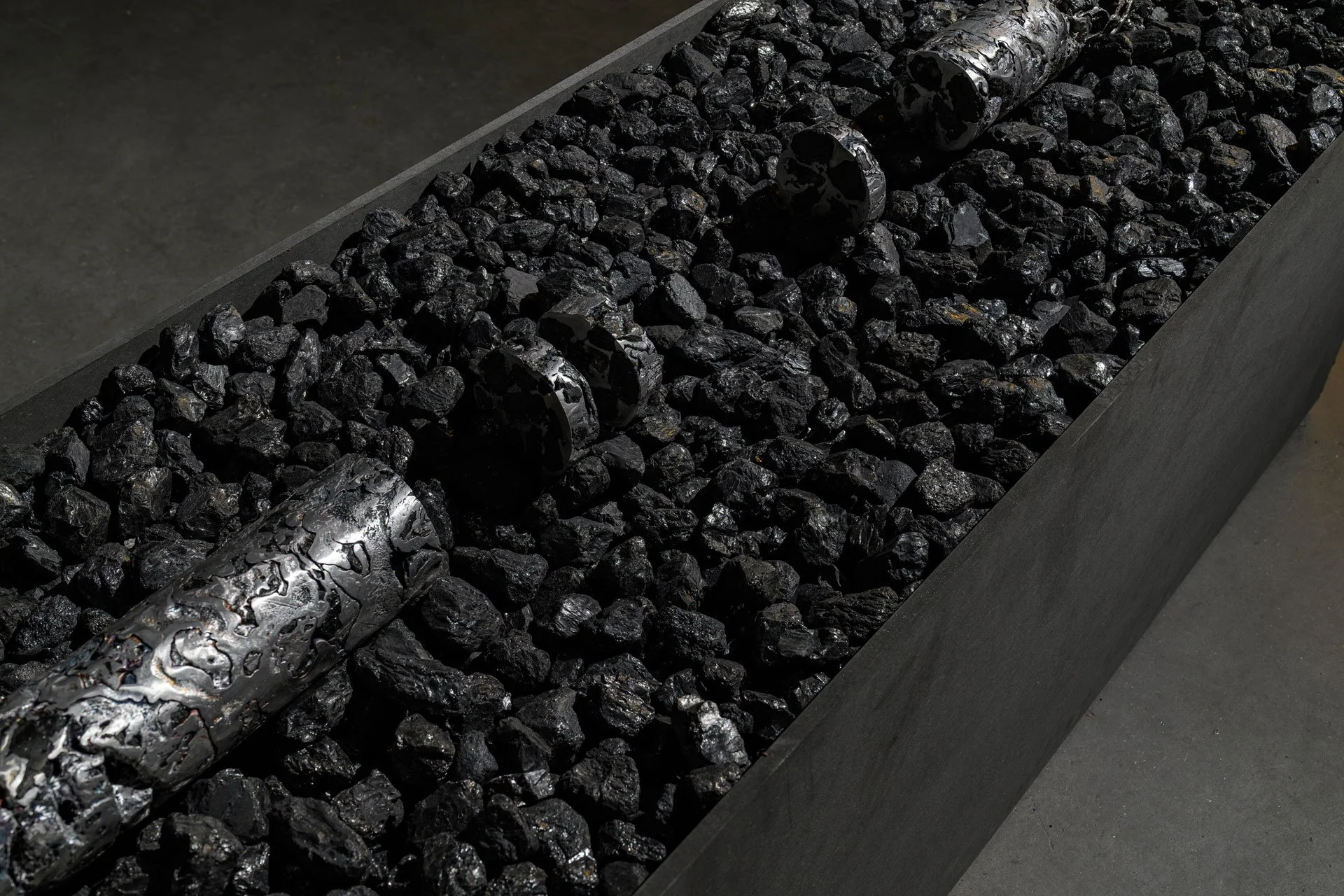
Sweat and Pheromones in the Rave Continuum
This article imagines rather than answering: a meandering reflection upon sweat (and its scent) through an hydrofeminist lens, in the context of raving culture. Ranging from bacterial decomposition and ecstatic practices, chiara pitrola tackles the micro and macro scales of dance as a biotechnology.
Rave continuum, 2024, illustration made by the author.
Thermoregulatory Solidarity
The last time I went dancing, it was very hot in the room. People were slipping into the steamy crowd with fans, offering to cool me off. "Pull up your hair," one says to me, I was confused, I lift them up and he starts waving it around my neck. The xeno-euphoria[1] is here, in all its aura, transmitted, reified from one body to another like a kink fantasy. Thermoregulatory solidarity? I thought.
The crowd-organism was taking care of each other's thermoregulation in a cocktail of volatile hormones. Hormones help us to better tolerate pain, pheromones help us to communicate when the music is too loud and sweat dissipates thermal energy from the skin in the club-cave-womb.
Sweat Ontologies
The poet Sophie Strand asked: “can a smell be a hyperobject[2], a networked phenomenon so inter-dimensional or conceptually vast that it evades our full comprehension?”[3]
This article is a meandering reflection upon sweat (and its scent) through an hydrofeminist lens[4], in the context of raving culture. Ravers as mammals moving due to sound. Their body as site of inscription and dance as chemical communication. Sweat, also known as perspiration, is connected with thermoregulation. A response to where the body is immersed in. Which chemical messages are exchanged through our sweat when dancing together? Which could be the panpsychic[5] qualities of sweat arising from dance as “a biotechnology of group formation?”[6]
Dionyisian Ecstatic Practices as Liminal Magnifiers
Raving is a contemporary iteration of ancient ecstatic practices that were meant to feel closer to the deities. The Italian scholar and raver Chiara Baldini outlines how Dionysus is a symbol of non-dualism, gender fluidity and pleasure.[7] Through Dionysian rites, one was able to heal, undergoing a process of transformation through a spiritual death and rebirth.
The space-time between death and rebirth is a liminal magnifier, opening to new possibilities through altered states experienced collectively. The writer, scholar, and raver McKenzie Wark calls this space of mammalian libidination “the rave continuum”.[8] A malleable dimension that allows unknown gestations through the repetition of sonic signals. With Wark the sonic dimension, as liberation and relation to the machine-soundsystem, has embodied and highly erotic connotations, altering the body through machinic orgasms.
Queering maenads" (2024), illustration made by the author. inspired by this 1894 print.
Posthuman Gestational Raving
Incognito gestations recall the notion of posthuman gestationality, discussed by Neimanis in Bodies of Water, founding text of hydrofeminism. It refers to the facilitative dynamic of bodily waters to gestate new life forms, and it is never fully knowable.[9] Through gestation, visible and invisible transits ebb and flow, like those of underground raving culture. Dissident dance is a gestational milieu in which porous bodies transcend their immune systems among tidal BPMs (beats per minute).
Raving, between escapism and hedonism, is also made of the need to cope with the present through suspension and release. For many, it is a way of hacking late capitalism routines filled with yet-to-be burnout, in which even self-care is commodified and chewed up by consumerism and obsessive productivity. For social minorities and the queer community raving is often a necessity, a form of body reappropriation as an antidote to marginalisation. One needs community care, and in some cases, one can find it on the dance floor. One needs safe spaces, and in some cases, one can find them in clubs. Care is tethered with pleasure activism, and the idea of community as an echo chamber gathered by Adrienne Marie Brown in her book on the politics of feeling good.[10] Her invitation to make more room for joy, allowing abundance and leaving shame behind, might have the power to deconstruct hedonism in its occasionally egotistic shades. Adrienne states that social structures should reflect strategies that go beyond denial or repression to navigate pleasure: parties, as liberating and fantasy engines, should do the same.
Sweat Legacy, Black Aesthetics, and Love Labour
Sweat’s legacy is tethered to labour and it is explored in African diasporic artist Andrea Valdés' dissertation on embodied epistemologies of sweat and spirit.[11] In her research, sweat is “the aqueous residue from our efforts, actions, and the processes we engage in creating and teaching dance” as well as “the literal biological function as well as the seen and unseen effort that goes into our creative work”.[12] She highlights how it is associated with the trauma of ancestors' forced labour and how it can be transformed through dance into Black aesthetics. As Andrea poetically refers to dance practices in terms of “kinetic joy” I would sustain and echo the possibility of healing through dance as transformative embodied love labour.
Spiritual Sauna
The smell of sweat comes from bacterial decomposition and while we (as human mammals) dance under the speakers — reappropriating the act as a personal and political hydraulic practice — exhausted, glistening, sweaty, some are able to process socio-political changes, trauma, catastrophe and contradiction through their body. Sophie Strand, describing the inter-dimensional qualities of smell refers to “aspects of being and perceiving that intersect across time, biolog(ies)/ ecolog(ies) and consciousness / subconsciousness, and even consciousness of the subconscious (supraconsciousness) via spirituality”.[13] Human mammals metabolise (also) through the useless, the repetitive, the darkness, the xeno-flesh in a sort of spiritual sauna. This perspirative cycle of death and rebirth somehow parallels the microscale of bacterial decomposition and its olfactory metamorphoses. Our sweat glands secrete oily fluids that contain proteins, lipids and steroids. It is only when commensal microbes metabolise these secretions that they produce odorous byproducts. Their biochemistry is still not completely clear, but we know that specific compounds have specific smells. The smell of every mammal is unique, and the composition of their sweat “varies according to factors such as fluid intake, external temperature, humidity, and some hormonal activity.”[14] Juicy vessels leaking such a biochemical vibrancy as sensuous fruity antennas.
The bioartist Paul Vanouse, which worked with cultures of its own sweat, asks: “if bacteria are responsible for our scent, then are we attracted to a person or their bacteria?”[15] The inherent proximity of a dancing crowd and the resulting inevitable exchange of bodily fluids is thus an interspecies choreography, that might alter emotional states or arousal due to fellow mammal scents and volatile compounds that we can’t see or control. It’s like a ghostly bath: oily, ambiguous, eloquent. The artist Yolanda Uriz[16], during her talk at FIBER Festival 2024, explained how smells have note scales just like music, as well as low, mid and high frequencies that we can perceive with almost 400 receptors through the reptilian brain: the oldest and most sophisticated layer of our brain. Therefore, olfactory pheromonal immersion transmits an incredible amount of information, regulating our memory and emotions.
Pheromones and Club as Bacterial Incubator
There are four types of pheromones: releasers (short-acting and linked to sexual attraction), modulators (found in sweat and impact emotions), primers (affect puberty and menstrual cycles) and signalers (provide information).[17] The duration of exposure and volatility of their compounds influences how they affect individuals: in the context of a clubbing experience, their exchange is intensified due to the crowd and the heat it releases. Reflecting on sweaty states and how they affect a group of people, I imagine the club as a bacterial incubator and proliferating steam bath. Sweat therapy studies seem to state that sweat helps group cohesion and produces less attrition throughout therapy.[18]
Perhaps both smell, sweat and the messages that they convey are hyperobjects, inhabiting and constellating rave’s complexities as macro and micro metabolic rituals of fermentation.
“sweet flesh would turn sour”
Seamus Heaney, “Death of a Naturalist” (1966)[19]
I invite the readers to think about decomposition the next time they sweat and to reconsider dance as a fractal state entangled with joy, frequencies and pores, synths and epidermis.
Postscript
While raving historically is a space of liberation and resistance, in the current political situation and ongoing colonial violence there has been much silence and grey areas. This article is dedicated to the collective @raversforpalestine that created a space for solidarity in club culture boycotting cultural institutions choosing to remain silent. They, as of June 2024, have currently a crowdfunding campaign to fund DJs and musicians “withdrawing from gigs in Germany in compliance with the STRIKE GERMANY initiative, as well as artists respecting boycotts in other countries.”[20]
Notes
[1] “Xeno-euphoria is a term created by McKenzie Wark to describe the ecstasy of becoming alien to oneself, riding the strangeness of the beats of techno music into somatics that are not honed into natural wholeness or a oneness but towards technological dissociation and a relational subjectivity. Wark suggests that the reason techno is a home to queer and trans communities is because this xeno-euphoria takes place, and splits space and time, outside of dominant visual regimes of what a body should look like or should feel like.” https://rosechoreographicschool.com/glossary/xeno-euphoria
[2] Defined by eco-philosopher, Timothy Morton. For more, see his book, Hyperobjects, here: https://www.upress.umn.edu/book-division/books/hyperobjects
[3] https://substack.com/@sophiestrand
[4] Hydrofeminism, coined by the scholar Astrida Neimanis, is an intersectional feminist theory offering imaginative tools to reflect on watery embodiment as a means of solidarity among bodies, species, materialities. The hydrofeminist imagery goes beyond metaphorical instances inviting to unlearn dualistic, extractive, neocolonial, xenophobic approaches that externalise and discretise the environment (and water) as an economic resource.
[5] “Panpsychism is the view that all things have a mind or a mind-like quality. The word itself was coined by the Italian philosopher Francesco Patrizi in the sixteenth century, and derives from the two Greek words pan (all) and psyche (soul or mind).” (https://iep.utm.edu/panpsych/) As sweat and pheromone related aerial chemical messages transmit information, here the author speculates associating this mind-like aspect to chemical compounds, even stretching further Strand’s question: suggesting here smell as hypersubject. Subjects regarded here broadly as vibrant message carriers, navigating bodily and aethereal contingency while questioning anthropocentric notions of intelligence.
[6] https://advaya.life/courses/dionysus-rave-ritual-and-revolution
[7] https://independent.academia.edu/chiarabaldini
[8] McKenzie Wark, Raving, Duke University Press, 2024.
[9] Astrida Neimanis, Bodies of Water, Bloomsbury Publishing, 2017.
[10] Adrienne Maree Brown, Pleasure Activism: The Politics of Feeling Good, AK Press, 2019.
[11] https://hdl.handle.net/11274/15634
[12] Ibid.
[13] https://substack.com/@sophiestrand
[14] https://www.elsevier.com/resources/anatomy/integument/epidermis/sweat/15991
[15] https://theconversation.com/an-artists-journey-into-the-science-of-sweat-119447
[16] https://yolandauriz.info/
[17] https://www.ncbi.nlm.nih.gov/pmc/articles/PMC3987372/
[18] https://journals.sagepub.com/doi/10.1177/105382590903200203
[19] https://www.poetryfoundation.org/poems/50981/blackberry-picking
Additional sources
https://www.verywellhealth.com/pheromones-7487001
https://www.psychologytoday.com/us/articles/200801/scents-and-sensibility
https://asm.org/articles/2021/december/microbial-origins-of-body-odor
https://www.verywellhealth.com/pheromones-7487001#citation-11
https://djmag.com/news/artists-withdraw-berlins-ctm-festival-support-strike-germany
https://www.instagram.com/raversforpalestine/
Martie Haselton, Hormonal, LITTLE BROWN & CO, 2018.
Read more

ABOUT THINKING BODIES
Thinking Bodies was conceptualised as an effort to build an exploratory body of knowledge(s), that draws upon the festival’s theme and weaves together perspectives, writing styles and formats. Drawing from the theme of the FIBER Festival 2024 edition, Outer/Body, we invited aspiring and emerging writers from a multiplicity of backgrounds to share their contributions, ranging from essays to interviews to poetries, resulting in a rich archive of knowledge.























